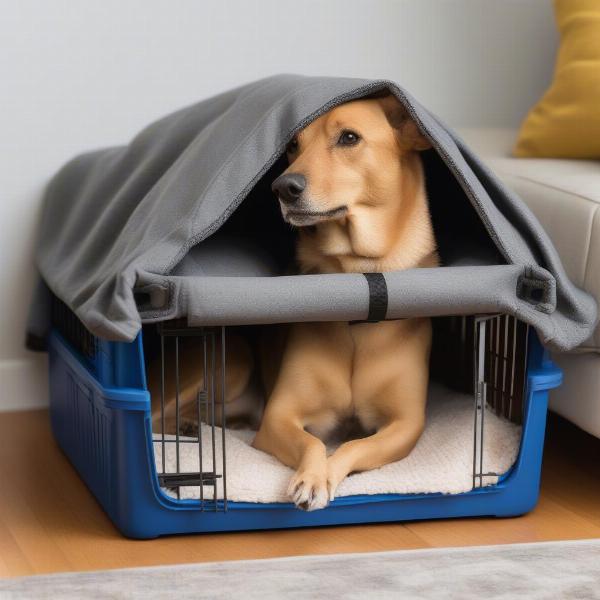The term “dog calming code” refers to a collection of signals and techniques used to help dogs feel safe, secure, and relaxed in stressful situations. From gentle touch and soothing sounds to specific body postures and pheromone products, understanding and utilizing these methods can significantly improve your dog’s well-being and strengthen your bond. Whether your dog suffers from separation anxiety, fears loud noises, or simply needs help adjusting to new environments, learning the dog calming code can be invaluable.
Decoding Canine Body Language: Recognizing Signs of Stress
Recognizing signs of stress in your dog is the first step in applying the calming code. A stressed dog might exhibit behaviors like excessive panting, yawning, lip licking, whale eye (showing the whites of their eyes), tucked tail, lowered body posture, or even shaking. Understanding these subtle cues allows you to intervene before the stress escalates.
Learning to interpret your dog’s body language is crucial. For example, a dog rolling onto its back isn’t always an invitation for a belly rub. In some cases, it can be a sign of appeasement or submission, indicating they feel uncomfortable.
Calming Signals: Speaking Your Dog’s Language
Dogs communicate with each other through a complex system of subtle body language signals, often referred to as “calming signals.” These signals are used to diffuse tension, avoid conflict, and express their emotional state. You can learn to use these same signals to communicate with your dog and create a sense of calm.
Some common calming signals include turning the head away, slow blinking, yawning, licking the nose, sniffing the ground, and approaching in a curve rather than directly. By incorporating these signals into your interactions, you can help your dog feel understood and less anxious.
Utilizing Calming Tools and Techniques
Beyond body language, there are several tools and techniques that can help soothe an anxious dog. These include:
- Touch: Gentle stroking or massage can be incredibly calming for dogs. Try slow, rhythmic strokes along their back or gentle ear rubs.
- Sound: Playing calming music or white noise can help mask frightening sounds and create a relaxing atmosphere.
- Pheromones: Synthetic dog appeasing pheromones (DAP) mimic the natural pheromones released by mother dogs to calm their puppies. These can be diffused in the air or applied as a spray or collar.
- Safe Spaces: Create a designated safe space for your dog where they can retreat when feeling overwhelmed. This could be a crate, bed, or even a corner of a room.
- Thundershirts: These snug-fitting vests apply gentle pressure to the dog’s body, which can have a calming effect, similar to swaddling a baby.
 Dog Wearing a Thundershirt in a Crate with a Pheromone Diffuser
Dog Wearing a Thundershirt in a Crate with a Pheromone Diffuser
Remember to introduce these tools and techniques gradually and observe your dog’s response. What works for one dog may not work for another, so it’s essential to find what best suits your individual dog’s needs.
Training and Consistency: Key Elements for Success
While the calming code can be incredibly effective, it’s crucial to remember that it’s not a quick fix. Consistency is key. Incorporate these techniques into your daily routine and during potentially stressful situations. Positive reinforcement training can also play a vital role in helping your dog build confidence and manage anxiety.
Conclusion: Creating a Calmer World for Your Canine Companion
By understanding and applying the dog calming code, you can significantly improve your dog’s overall well-being and create a more harmonious relationship. Learning to recognize your dog’s stress signals, utilizing calming signals yourself, and incorporating calming tools and techniques can help your dog navigate challenging situations and live a happier, more relaxed life. Remember, patience and consistency are essential for success.
FAQ:
- What is the most important aspect of the dog calming code? Recognizing and responding to your dog’s individual stress signals.
- Can I use the dog calming code with any breed of dog? Yes, the principles of the calming code apply to all breeds, but individual dogs may respond differently to specific techniques.
- How long does it take for the calming code to work? The time it takes to see results varies depending on the dog and the situation. Consistency is crucial for long-term success.
- Are there any risks associated with using calming signals or tools? No, when used correctly, these techniques are safe and can greatly benefit your dog.
- Where can I learn more about dog calming signals? Many resources, including books and online articles, provide detailed information about canine communication and calming signals.
About ILM Dog
ILM Dog is your trusted international resource for expert advice on all aspects of dog care and well-being. We offer comprehensive guidance on dog breeds, health, training, nutrition, grooming, and much more. Whether you’re a new dog owner or a seasoned expert, ILM Dog provides practical, evidence-based information to help you provide the best possible care for your canine companion. Contact us today via email at [email protected] or by phone at +44 20-3965-8624. We look forward to hearing from you!